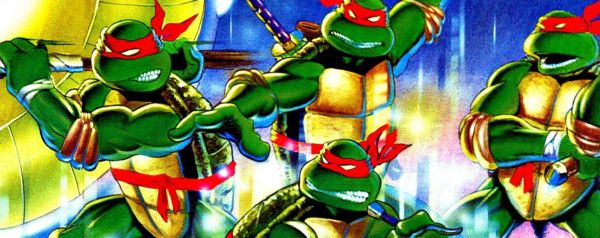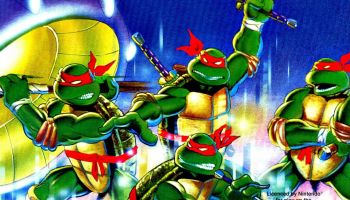
A pencil used to be one of the most relied-upon parts of a game developer’s toolkit. But thanks to the rise of computer-generated imagery, the humble pencil has certainly become less important over time.
So for this edition of Bite-Sized Game History, we’ll travel back to the days of graph paper and lightboxes, and look at a more modern example of a time when hand-drawn artwork was used in game development.
![]() You can find a lot of dedicated video game historians on Twitter, and in 280 characters or less, they always manage to unearth some amazing artifacts. Bite-Sized Game History aims to collect some of the best stuff I find on the social media platform.
You can find a lot of dedicated video game historians on Twitter, and in 280 characters or less, they always manage to unearth some amazing artifacts. Bite-Sized Game History aims to collect some of the best stuff I find on the social media platform.
The first Teenage Mutant Ninja Turtles game for the NES has developed a certain reputation for difficulty over the years. While the whole game is pretty hard, most of its controller-smashing moments can be found in the game’s second level, popularly known as “The Dam.”
Mastering “The Dam” requires fighting through to the top of the concrete structure and then diving into the Hudson River below to disarm a series of bombs set by Shredder. What makes this level particularly tricky is that players must navigate all four Turtles through the “Criminally Polluted” waterway while threading a gauntlet of electrified seaweed. Keeping at least one Turtles alive in the mazelike tunnels was almost impossible for an amateur and surely resulted in at least a few smashed controllers.
Thankfully, the Nintendo Game Play Counselors at the Nintendo Power Hotline could ride to the rescue if you got stuck in Teenage Mutant Ninja Turtles (or any other NES game). The counselors didn’t have a searchable database in the late 80s (they weren’t even required to play games themselves, though most did), but what they did have was a collection of hand-drawn maps to help guide your way.
All of the maps and strategy guides were created in-house by the counselors themselves and made a call for help worth every penny. The Nintendo Power Hotline closed down in 2005, but Art of Nintendo Power recently shared some pages from the Teenage Mutant Ninja Turtles binder:
In honor of the #CowabungaCollection collection, here are some maps for the TMNT NES game that were used by Nintendo Game Play Counselors. To my knowledge these have never been shown online. Enjoy! pic.twitter.com/vFrHHxhMs1
— Art of Nintendo Power ➡️ PRGE 2022 (@ArtofNP) September 2, 2022
Insomniac’s Spider-Man 2 will pit the wallcrawler against Venom and it’ll very likely raise the bar for graphical fidelity when it’s released this Fall.
Venom has spent the last few years waffling between monstrous villainy and reluctant heroism, but he was first introduced as Spider-Man’s dark half in 1984. Roughly a decade later, the alien symbiote made its interactive debut in 1994’s Spider-Man and Venom: Maximum Carnage. Released for the Super NES and Genesis as an eye-popping red-colored cartridge, the game was one of the last Spider-Man titles to be created using traditional animation.
Developer Kevin Edwards recently shared a short clip of his time at Software Creations demonstrating the process with animator Alan Moult holding the pencil. The behind-the-scenes video shows how the SNES game’s characters were brought to life using flipbook-like drawings that were scanned and captured using a lightbox, and then cleaned up and colored using image editing software:
Alan Moult working on the sprite animations of a baddie in Software Creations' SNES / Genesis game 'Maximum Carnage'. Proper old-school animation techniques being used before being scanned, coloured and tidied up in DPaint on a PC. Video by @chunwahkong circa 1994. #animation pic.twitter.com/TjbpZlDIb1
— Kevin Edwards ( Retro Videogame development ) (@KevEdwardsRetro) March 10, 2023
Studio MDHR is one of the developers keeping the flame lit on using traditional animation for game development… which even extends to early mockups.
Jake Clark worked as a designer on Cuphead, and he pitched boss fights to his colleagues using Flash-animated drawings from his sketchbook. He recently shared one of these clips, a battle against a massive mermaid known as Cala Maria, and even included a bit of the game’s jazzy soundtrack to give it a bit of a kick. The character is slightly different on the drawing board than what we ended up with in the final game, but it’s interesting to see how much of her attack pattern was there right from the start:
Here's a mockup I made to pitch how the Cala Maria fight could go, before we started working on it. Made in Flash with scanned drawings from my sketchbook (added music for fun) #Cuphead pic.twitter.com/sp8ECVJ0xc
— Jake (@JakeClarkDude) September 9, 2022
Thanks to Art of Nintendo Power, Kevin Edwards, and Jake Clark for signing off on these small peeks into the world of hand-drawn game development.

